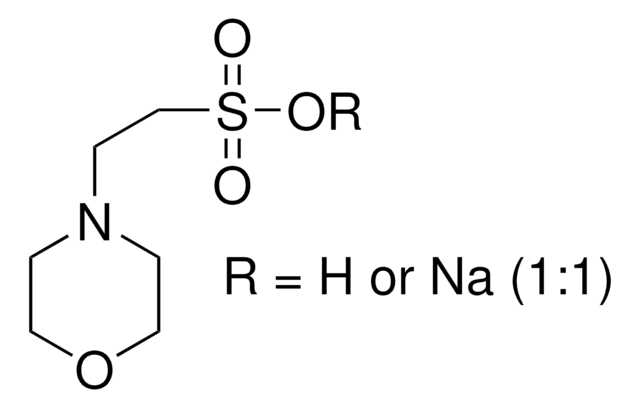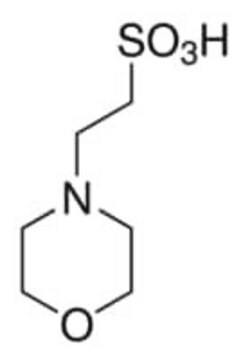69889
MES monohydrate
BioUltra, for molecular biology, ≥99.5% (T)
Synonym(s):
2-Morpholinoethanesulfonic acid hydrate,, 2-morpholin-4-ylethanesulfonic acid;hydrate, 2-(N-Morpholino)ethanesulfonic acid, 4-Morpholineethanesulfonic acid monohydrate
About This Item
Recommended Products
grade
for molecular biology
Quality Level
product line
BioUltra
Assay
≥99.5% (T)
form
powder or crystals
impurities
DNases, none detected
Insoluble matter, passes filter test
Phosphatases, none detected
Proteases, none detected
RNases, none detected
ign. residue (900 °C)
≤0.05% (as SO4)
pH
2.5-4.0 (25 °C, 0.5 M in H2O)
useful pH range
5.5-6.7
pKa (25 °C)
6.1
mp
>300 °C (lit.)
solubility
H2O: 0.5 M at 20 °C, clear, colorless
density
10.66 g/mL
anion traces
chloride (Cl-): ≤50 mg/kg
sulfate (SO42-): ≤50 mg/kg
cation traces
Al: ≤5 mg/kg
As: ≤0.1 mg/kg
Ba: ≤5 mg/kg
Bi: ≤5 mg/kg
Ca: ≤20 mg/kg
Cd: ≤5 mg/kg
Co: ≤5 mg/kg
Cr: ≤5 mg/kg
Cu: ≤5 mg/kg
Fe: ≤5 mg/kg
K: ≤50 mg/kg
Li: ≤5 mg/kg
Mg: ≤5 mg/kg
Mn: ≤5 mg/kg
Mo: ≤5 mg/kg
Na: ≤50 mg/kg
Ni: ≤5 mg/kg
Pb: ≤5 mg/kg
Sr: ≤5 mg/kg
Zn: ≤5 mg/kg
λ
0.5 M in H2O
UV absorption
λ: 260 nm Amax: 0.025
λ: 280 nm Amax: 0.020
SMILES string
O.OS(=O)(=O)CCN1CCOCC1
suitability
suitable for DNase I test
suitable for Western blot
suitable for molecular biology
application(s)
clinical research
diagnostic assay manufacturing
life science and biopharma
foreign activity
DNase, none detected
NICKase, none detected
RNase, none detected
protease, none detected
InChI
1S/C6H13NO4S.H2O/c8-12(9,10)6-3-7-1-4-11-5-2-7;/h1-6H2,(H,8,9,10);1H2
InChI key
MIIIXQJBDGSIKL-UHFFFAOYSA-N
Looking for similar products? Visit Product Comparison Guide
General description
Application
- In the preparation of a solution used for the suspension and dilution of protoplasts to measure the density and number of protoplasts using a haemocytometer
- As a component of Murashige and Skoog basal salt media
- In the preparation of total ionic strength adjustment buffer (TISAB)
- as a constituent in mobile phase solutions employed for the analysis of high molecular weight species and charge-related variants of biopharmaceutical proteins through SEC, HIC, and IEX chromatographic techniques
Features and Benefits
- Suitable as a Buffer component, for Electrophoresis and Molecular Biology
- Effective Buffering from pH 2.5-4.0 (25 °C, 0.5 M in H2O) with a pKa of 6.1 (25 °C)
- Free from DNase, NICKase, RNase, and Protease
Preparation Note
Other Notes
Sterilization: Sterilization should be by filteration through 0.2 uM filters. Autoclaving is not recommended by any sulfonic acid buffers. If buffers must be nuclease-free, it is best to treat the water, and then add the buffer solids after autoclaving. When MES solutions are autoclaved, they turn yellow (although pH does not change measurably. The identity of the yellow breakdown product is unknown.
Storage Class Code
11 - Combustible Solids
WGK
WGK 1
Personal Protective Equipment
Choose from one of the most recent versions:
Already Own This Product?
Find documentation for the products that you have recently purchased in the Document Library.
Customers Also Viewed
Our team of scientists has experience in all areas of research including Life Science, Material Science, Chemical Synthesis, Chromatography, Analytical and many others.
Contact Technical Service






